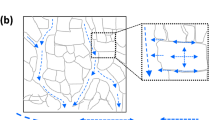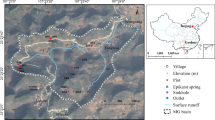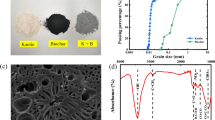Abstract
Freshly excavated overburden (spoils) dumped during open-cut coal mining generate saline leachate that can lead to environmental impacts. Predictions of leachate salinity remain uncertain, largely due to incomplete knowledge of responses of spoils to varying moisture conditions. This study carried out column leaching experiments on four spoil types, originating from Queensland, Australia. Following characterisation of the fresh spoil material, four moisture regimes were tested: three wetting-drying conditions with leaching occurring biweekly, weekly, and fortnightly and one completely saturated regime with leaching occurring weekly. Thirty-four leaching cycles were conducted except for one spoil type for which only 12 cycles were completed. Results showed higher EC and leachate ion concentrations from the saturated regime, while among the wetting-drying regimes, the spoil leached on a fortnightly basis resulted in higher salt release for two geochemically similar spoil types. Overall, lower and steady pH was recorded for spoils leached under saturated conditions. Irrespective of spoil type, sodium was the dominating cation contributing to the overall leachate salinity. The paper provides new insights into parameterising leaching models and in the role of water-rock interactions which informs experimental design and conceptualisation of full-scale models.







Similar content being viewed by others
Data Availability
The data generated and analysed during the current study is available from the corresponding author on reasonable request.
References
Åberg, G., Jacks, G., Wickman, T., & Hamilton, P. J. (1990). Strontium isotopes in trees as an indicator for calcium availability. CATENA, 17, 1–11.
Al-Sibai, M., Adey, M. A., & Rose, D. A. (1997). Movement of solute through a porous medium under intermittent leaching. European Journal of Soil Science, 48, 711-725.
AMIRA. (2002). ARD Test Handbook, Project P387A Prediction & Kinetic control of acid mine drainage. https://www.resolutionmineeis.us/sites/default/files/references/amira-2002.pdf. Accessed 11 May 2021. Ian Wark Research Institute and Environmental Geochemistry International Pty Ltd.
Annandale, J. G., Jovanovic, N. Z., Pretorius, J. J. B., Lorentz, S. A., Rethman, N. F. G., & Tanner, P. D. (2001). Gypsiferous mine water use in irrigation on rehabilitated open-cast mine land: crop production, soil water and salt balance. Ecological Engineering, 17, 153–164.
Bernhardt, E. S., & Palmer, M. A. (2011). The environmental costs of mountaintop mining valley fill operations for aquatic ecosystems of the Central Appalachians. Annals of the New York Academy of Sciences, 1223, 39–57. https://doi.org/10.1111/j.1749-6632.2011.05986.x
Daniels, W. L., Orndorff, Z., Ross, C., Koropchak, S., Zipper, C., Evans, D., & Eick, M. (2014). Correlation of TDS release potentials with field leaching behaviors for Appalachian coal mine spoils and coarse refuse. report submitted to the office of surface mining.
Daniels, W. L., Zipper, C. E., Orndorff, Z. W., Skousen, J., Barton, C. D., Mcdonald, L. M., & Beck, M. A. (2016). Predicting total dissolved solids release from central Appalachian coal mine spoils. Environmental Pollution, 216, 371–379.
David, K., Prathapar, S. A., Creelman, R. A., & Hancock, G. R. (2004). Management of salinity issues for closure of open cut coal mines. ACARP.
Edraki, M., Mcintyre, N., Baumgartl, T., & Hilton, M. (2019). Prediction of long-term salt generation from coal spoils ACARP C25039.
Elliott, G. L. (1983). The movement of soluble minerals in overburden from an open-cut coal mine in the upper hunter valley.: Scone Conservaton Services onf New South Wales.
Emmerton, B., Burgess, J., Esterle, J., Erskine, P., & Baumgartl, T. (2018). The application of natural landform analogy and geology-based spoil classification to improve surface stability of elevated spoil landforms in the Bowen Basin, Australia—a review. Land Degradation & Development, 29, 1489–1508.
Ferguson, K. D. & Erickson, P. M. (1988). Pre-mine prediction of acid mine drainage. In: Salomons, W. & Forstner, U. (Eds.), Environmental management of solid wastes dredged material and mine tailings. New York: Springer-Verlag. https://doi.org/10.1007/978-3-642-61362-3
Fielding, C. R., Falkner, A. J., & Scott, S. G. (1993). Fluvial response to foreland basin overfilling; the Late Permian Rangal Coal Measures in the Bowen Basin, Queensland, Australia. Sedimentary Geology, 85, 475–497.
Fielding, C. R., Kassan, J., & Draper, J. J. (1996). Geology of the Bowen and Surat Basins, Eastern Queensland. Geological Society of Australia.
Fityus, S., Hancock, G., Wells, T., Ford, J., & Simic, E. (2007) The environmental geotechnics of coal mine spoil. Common Ground Proceedings 10th Australia New Zealand Conference on Geomechanics Brisbane.
Fookes, P. G., Gourley, C. S., & Ohikere, C. (1988). Rock weathering in engineering time. Quarterly Journal of Engineering Geology and Hydrogeology, 21, 33.
Geidel, G. (1979). Alkaline and acid production potentials of overburden material: the rate of release. Reclam. Rev, 2:3/4.
Gerke, H. H., & Van Genuchten, M. T. (1996). Macroscopic representation of structural geometry for simulating water and solute movement in dual-porosity media. Advances in Water Resources, 19, 343–357.
Hillel, D. (1982). Introduction to soil physics. Academic Press.
Hilton, M. (2020). Predicting salt generation from coal mine spoil heaps in a semi-arid climates. Doctorate The University of Queensland.
Hilton, M., Shaygan, M., Mcintyre, N., Baumgartl, T., & Edraki, M. (2019). The effect of weathering on salt release from coal mine spoils. Minerals, 9, 760. https://doi.org/10.3390/min9120760
Hood, W. C., & Oertel, A. O. (1984). A leaching column method for predicting effluent quality from surface mines. In: Graves, D., ed. National Symp. on Surface Mining, Hydrology, Sedimentology, and Reclamation, 2-7 December 1984 Lexington Ky. Univ. of Kentucky College of Eng., Lexington, KY, 271-277.
Jacks, G., Åberg, G., & Joseph Hamilton, P. (1989). Calcium budgets for catchments as interpreted by strontium isotopes. Hydrology Research, 20, 85–96.
Jones, C. E., Vicente-Beckett, V., & Chapman, J. (2019). Coal mine-affected water releases, turbidity and metal concentrations in the Fitzroy River Basin, Queensland, Australia. Environmental Earth Sciences, 78. https://doi.org/10.1007/s12665-019-8734-x
Juang, F. H. T., & Johnson, N. M. 1967. Cycling of chlorine through a forested watershed in New England. 72, 5641-5647.
Mcintyre, N., Jain, K. R., & Edraki, M. (2021). Modelling of Salt Leaching from Coal Mine Spoils at Two Scales. Mine Water and the Environment. https://doi.org/10.1007/s10230-021-00797-9
Nickman, M., Spaun, G., & Thuro, K. (2006). Engineering geological classification of weak rocks. 10th International IAEG Congress, 6–10 September 2006 Nottingham, UK.
Nugraha, C., Shimada, H., SasaokaA, T., Ichinose, M., Matsui, K., & Manege, I. (2009). Geochemistry of waste rock at dumping area. International Journal of Mining, Reclamation and Environment, 23, 132–143.
Orndorff, Z., Daniels, W. L., Beck, M., & Eick, M. (2010). Leaching potentials of coal spoil and refuse: acid-base interactions and electrical conductivity. 27th Annual Meeting of the ASMR, June 4-10, 2010, Pittsburgh, Pennsylvania. 736-766.
Orndorff, Z. W., Daniels, W. L., Zipper, C. E., Eick, M., & Beck, M. (2015). A column evaluation of Appalachian coal mine spoils’ temporal leaching behavior. Environmental Pollution, 204, 39–47.
Paktunc, A. D. (1999). Characterization of mine wastes for prediction of acid mine drainage. In: Azcue, J. M. (ed.) Environmental impacts of mining activities: emphasis on mitigation and remedial measures. Springer Berlin Heidelberg.
Parker, J. M. (2013). Effect of various saturation levels, leaching solution ph, and leaching cycle on electrical conductivity from coal mine spoil leachate. Master of Science in Crop and Soil Environmental Sciences Thesis, Virginia Polytechnic Institute and State University.
PPK. (2001). Water quality and discharge predictions for final void and spoil catchments. In: C7007, A. P. N. (ed.).
QDME. (1995). Technical guidelines for environmental management of exploration and mining in Queensland. In: ENERGY, Q. D. O. M. A. (ed.). Brisbane.
Rayment, G. E., Lyons, D. J., & Lyons, D. J. (2011). Soil chemical methods: Australasia. CSIRO.
Shaw, R., Brebber, L., Ahern, C., & Weinand, M. (1994). A review of sodicity and sodic soil behavior in Queensland. Soil Research, 32, 143–172.
Shaygan, M., Reading, L. P., & Baumgartl, T. (2017). Effect of physical amendments on salt leaching characteristics for reclamation. Geoderma, 292, 96–110.
Simmons, J., Fityus, S., DOonnelly, B., & Hammond, A. (2015). Moisture conditions in mine spoil dumps. Bowen Basin Symposium.
Smith, L., Lopez, D., Beckie, R., Morin, K., Dawson, R., & Price, W. (1995). Hydrogeology of waste rock dumps. Department of Natural Resources Canada.
Sobek, A. A., Skousen, J. G., & Fisher JR., S. E. (2000). Chemical and physical properties of overburdens and minesoils. Reclamation of Drastically Disturbed Lands.
Stewart, B. R., Daniels, W. L., & Jackson, M. L. 1997. Evaluation of Leachate Quality from Codisposed Coal Fly Ash and Coal Refuse. Journal of Environmental Quality, 26, 1417-1424. https://doi.org/10.2134/jeq1997.00472425002600050031x
Strosnider, W. H. J., Hugo, J., Shepherd, N. L., Holzbauer-Schweitzer, B. K., Herve-Fernandez, P., Wolkersdorfer, C., & Nairn, R. W. (2020). A snapshot of coal mine drainage discharge limits for conductivity, sulfate, and manganese across the developed world. Mine Water and the Environment, 39, 165–172.
Struthers, P. H. (1964). Chemical weathering of strip-mine spoils. The Ohio Journal of Science, 64, 125–131.
Szczepanska, J., & Twardowska, I. (1999). Distribution and environmental impact of coal-mining wastes in Upper Silesia, Poland. Environmental Geology, 38, 249–258.
Tiwary, R. K. (2001). Environmental impact of coal mining on water regime and its management. Water, Air, and Soil Pollution, 132, 185–199.
US EPA. (2011). Method 1627: Kinetic test method for the prediction of mine drainage quality. In: EPA, U. (ed.). Washington DC: US EPA Office of Water.
Wu, Y. S., Ritcey, A. C., & Bodvarsson, G. S. (1999). A modeling study of perched water phenomena in the unsaturated zone at Yucca Mountain. Journal of Contaminant Hydrology, 38, 157–184.
Younger, P. L. (2004). Environmental impacts of coal mining and associated wastes: a geochemical perspective. Geological Society Special Publication, 236, 169–209.
Acknowledgment
The authors would like to thank Vinod Nath, Melinda Hilton, Thomas Baumgartl, and Ian Callow for their assistance with the project. The authors would also like to thank the anonymous reviewers who provided helpful comments on the earlier version of the paper.
Funding
The funding for this research was provided by the Australian Coal Association Research Program, project number C25039 and C28043.
Author information
Authors and Affiliations
Contributions
Karan Rishabhkumar Jain: conceptualisation, methodology, formal analysis, investigation, writing—original draft. Mansour Edraki: conceptualisation; methodology; writing, review and editing; supervision; funding acquisition. Neil McIntyre: conceptualisation; methodology; writing, review and editing; supervision; funding acquisition.
Corresponding author
Additional information
Publisher’s Note
Springer Nature remains neutral with regard to jurisdictional claims in published maps and institutional affiliations.
Rights and permissions
About this article
Cite this article
Jain, K.R., Edraki, M. & McIntyre, N. Controls of Wetting and Drying Cycles on Salt Leaching from Coal Mine Spoils. Water Air Soil Pollut 232, 472 (2021). https://doi.org/10.1007/s11270-021-05422-7
Received:
Accepted:
Published:
DOI: https://doi.org/10.1007/s11270-021-05422-7









